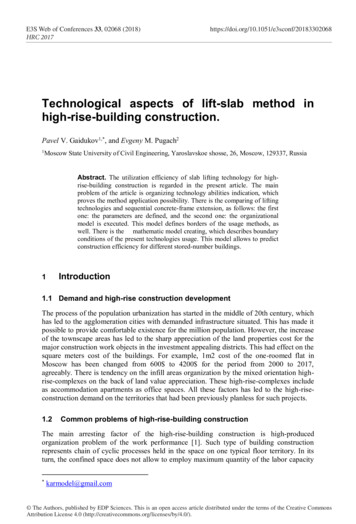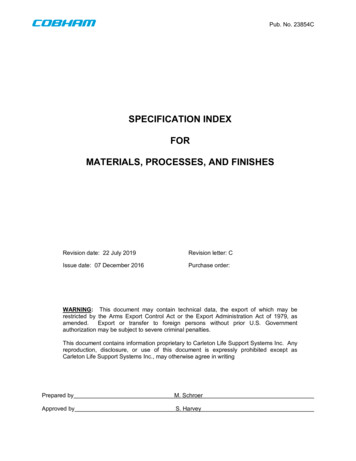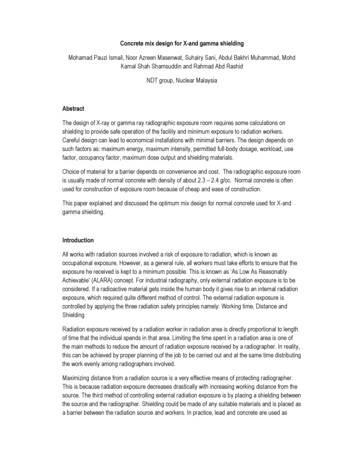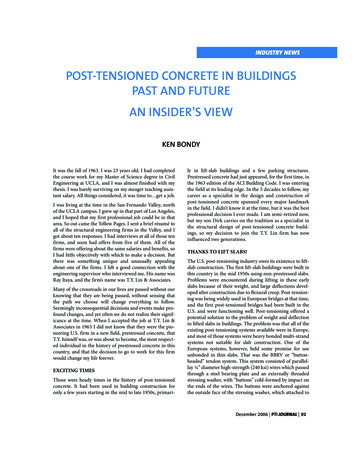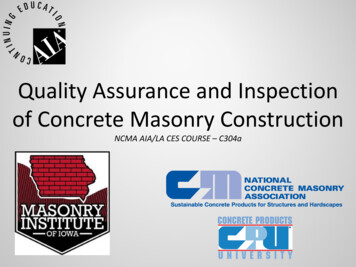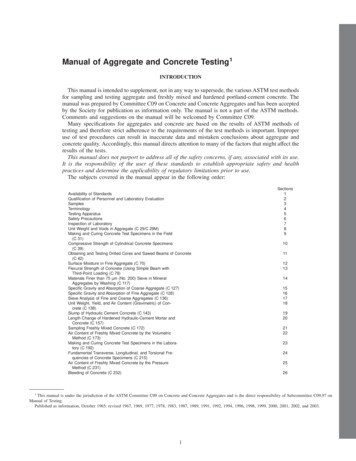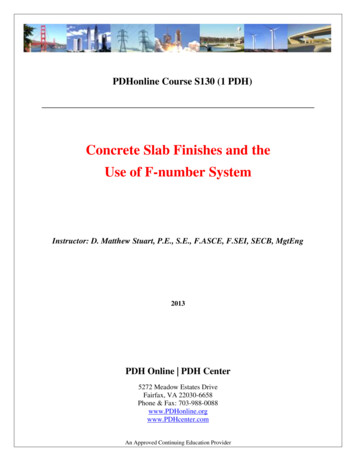
Transcription
PDHonline Course S130 (1 PDH)Concrete Slab Finishes and theUse of F-number SystemInstructor: D. Matthew Stuart, P.E., S.E., F.ASCE, F.SEI, SECB, MgtEng2013PDH Online PDH Center5272 Meadow Estates DriveFairfax, VA 22030-6658Phone & Fax: 703-988-0088www.PDHonline.orgwww.PDHcenter.comAn Approved Continuing Education Provider
ing in the 1970’s, ACI targeted the conventional 1/8” in 10’-0” floor finish, or “straightedgespec”, as an area that needed more uniform and realistic methods of specification andmonitoring. This need was felt because of the ambiguous nature of the traditional straightedgespecification. For example 1/8" in 10'-0" could mean either of the two conditions shown inFigure 1 below.In addition, the straightedge method had no standard test method; therefore field conditionswere often subject to interpretation. For example does the spec 1/8" in 10'-0" mean thatmeasurements are taken at points both 360 and 90 from each other? Are measurementscumulative along lengths greater than 10’-0”? Finally, the straightedge specs do not address floorflatness (roughness or wash boarding) or levelness (tilt or slope).What are F-Numbers?The F-Number system is a statistical method of evaluating horizontal concrete surfaces forflatness and levelness. The Face Company, in conjunction with ACI Committee 117, developedthe basis for the system through the use of a patented continuous Profileograph machine. For atypical random traffic industrial or other similar floor slab there are two F-Numbers used toevaluate the floor flatness and levelness, FF and FL; respectively. FF (flatness) is most affected bythe finishing operation. FL (levelness) is most affected by forming and strike-off. Both numbersare dimensionless and the higher the number the more accurate the floor construction.The FF number relates to the rate of change of the elevation of a concrete floor over a 12"interval. The rate of change of slope is represented by the value q. A hump in a slab produces anegative q value while a trough or depression produces a positive q. FF is calculated using thefollowing formula:FF 4.57 / ((3 x Sq) ( q ))Where: D. Matthew StuartSq the standard deviation of q q the absolute value of the mean of q
www.PDHcenter.comwww.PDHonline.orgThe FL number relates to the general floor slope of a concrete slab from an assumed datumelevation. The difference in elevation of two points which are 10'-0" apart are measured as the valuez. FL is calculated using the following formula:FL 12.5 / ((3 x Sz) ( z ))Where:Sz the standard deviation of z z the absolute value of the mean of zFor defined traffic industrial floor slabs, such as very-narrow-aisle warehouses where forkliftstravel the same path, an Fmin numerical system is used. Fmin is not calculated like FF or FL. Fmin isactually a direct measurement of the floor surface in the wheel path of the forklift for which thedefined traffic area is designed. An Fmin100 specification is a baseline number corresponding to aflatness tolerance of 1/8" in 10'-0". An Fmin50 specification corresponds to a flatness tolerance of1/8" in 5'-0", or 1/4" in 10'-0".Source: T2 Storage Solutions D. Matthew Stuart
www.PDHcenter.comwww.PDHonline.orgHow are F-Numbers Specified?ACI 117 is the industry standard for the use of the F-Number system and establishes the F-Numbersof different types of floors as well as the definitions of acceptable variances. ACI 302 also providesguidelines for the placing and finishing of concrete floor slab construction for the F-Numbersystem. ASTM E 1155 is the basis of the standard test method for the FF and FL number system.One of the most important aspects of establishing F-Numbers is to not over specify beyond thatwhich is really required for a given project. This is because an increase in required floor quality willalmost always result in higher costs. One of the best methods for determining the mostappropriate criteria to specify for a project is to measure existing floors that are performingsatisfactorily. Specifications should state the performance criteria only and not specify the methodof obtaining the required tolerances. This is recommended because the quality of work varies fromfinishing crew to finishing crew for any given standard technique used in the field.Source: Warehouse & Logistics NewsFF and FL are typically specified for both overall and minimum local values. This helps prevent theacceptance of isolated local areas of low quality construction due to it being averaged in withother areas of the slab that surpass the minimum requirements. The specified overall valuesdescribe the flatness and levelness values that must be achieved when all measured values on agiven test surface are combined. The minimum local values describe the flatness and levelnessvalues below which repair or replacement is required within the affected area. The general ruleof thumb is that the local area minimum must be within 2/3 of the specified overall value. Onelevated slabs the FL levelness tolerance does not apply because of the deflection of the overallframing system and should therefore not be specified. Only FF numbers should be specified forelevated slabs.Source: TTL Inc. D. Matthew Stuart
www.PDHcenter.comwww.PDHonline.orgLift and forktruck manufactures publish recommended Fmin floor tolerances to assure the properoperation of their equipment. The higher the number the flatter and more level the floorrequirement is. Fmin100 is typically referred to as a "Superflat" floor requirement. Producing anFmin100 tolerance in any direction on a floor is comparable to producing a floor surface meetingFF140 and FL100 tolerances.Source: Creamer MediaAn additional ASTM specification, E 1486 can be used to determine the deviation from a 10-footstraightedge for both random and defined traffic floors in order to determine the "WavinessIndex". In addition this specification provides defined wheel track equations for specifyingelevation differences and change in elevation transversely between left and right wheel tracksand longitudinally from front to rear axle , therefore this spec can be used as a standard forevaluating Fmin floor tolerances.Source: Dynamic Floor Specialists D. Matthew Stuart
www.PDHcenter.comwww.PDHonline.orgThe following table can be used as a guideline for specifying F-Numbers for various floor profilecategories:Recommended F-Numbers for Various Floor Profile CategoriesRandom Traffic FloorsFloor Profile CategorySpecified Overall ValueMinimum Local ValueDefined TrafficFloorsFFFLFFFLFminConventional(using bullfloat)1913131019Conventional(using highway 0Very 7550150In addition, although there is no direct equivalence between F-Numbers and traditional straightedgespecifications the following table provides an approximate correlation between straightedgemeasurements and FF Numbers.Approximate Equivalence of FF Numbers and Straightedge MeasurementsF-Number D. Matthew StuartGap Under 10’-0” 8”
www.PDHcenter.comwww.PDHonline.orgHow are F-Numbers Measured?Floor flatness and levelness tests should be conducted anywhere from within 16 to 72 hours aftercompletion of the final troweling operation, depending on the project type and requirements. Asit is typically not practical to obtain acceptable local values across construction joints it isrecommended that these areas be omitted from consideration for comparison to the specifiedminimum local value. It should also be noted that it is entirely possible that the floor can bewithin specified tolerances during the initial testing process but become out of spec prior toactual use because of slab cracking, curling or sub-grade settlement.ASTM E1155 is the governing specification for the testing procedures used to determine floorflatness and levelness for random traffic floors. This standard allows for numerous techniques forgathering the required date including levels, inclinometers, Profilometers and other means. Oneof the most often used pieces of equipment for these measurements is the Dipstick floor profiler,an apparatus that can field measure both floor flatness and levelness. This equipment can beprogrammed to measure floor slabs on slopes also.Source: Concrete Bindings LTDFor defined traffic floors such as rack aisleways where the wheel traffic occurs in the samelocation for all operations, instead of random sampling, traffic paths are directly measured usinga continuous recording floor Profilometer configured to run in exactly the same specified wheeltracks as the forktrucks. The results of the measurements taken do not produce F-Numbers, butinstead simply confirm compliance with the minimum requirements specified. Changes inelevation and rate of change are confirmed in both the longitudinal and transverse direction ofthe wheel travel. The record of measurements indicates the exact location of any areas that arenot in compliance.Source: CoGri Korea Company D. Matthew Stuart
www.PDHcenter.comwww.PDHonline.orgConcrete Slab Finishing Specification Example:The following is an example of a performance-based specification for concrete finishing as it relates to the F-Number system. Red text that is located withinbrackets indicates alternate or optional items depending on the nature of the project:A.Concrete Finish: Concrete finish floors shall have a [hard steel troweled finish; light broom finish] unless indicated otherwise on the drawings. Place, strike off,consolidate, level and float to the proper elevation. Troweling shall begin after surface has received a float finish. The slab drying must proceed naturally andmust not be hastened by the dusting on of dry cement or sand. Lightly tool all edges at construction joints and exercise care that slab edges are not depressedalong bulkheads during finishing operations, particularly hand troweling. Exterior slabs, sidewalks, pads and ramps shall have a light broom finish unlessindicated otherwise on the drawings. Provide standard trowel finish at all sub-slabs.1.Random traffic floors shall conform to the following surface profile tolerances:Floor Designation: All floor areas not specified to be part of the "defined traffic floor" should be part of the "random traffic floor". Any floor slabcomprising part of the random traffic floor shall be designated a “random traffic slab".b.Flatness and Levelness Tolerances: The random traffic floor shall conform to the following surface profile tolerances:Floor Flatness Number: FFSpecified Overall Value [35]Minimum Local Value [24]Floor Levelness Number: FLSpecified Overall Value [25]Minimum Local Value [18]c.Floor Tolerance Measurements: FF and FL tolerances shall be tested in accordance with ASTM E 1155. Actual overall F-numbers shall be calculated usingthe inferior / superior area method.d.Timeliness of Floor Profile Tests & Reports: All floor tolerance measurements shall be made within [48] hours after slab installation. In all cases, tolerancemeasurements shall precede the removal of shores and forms. Results of all floor profile tests (including a running tabulation of the overall FF and FLvalues for all of the random traffic slabs installed to date) shall be provided to the Contractor within [72] hours after each slab installation.e.Remedy for Out-of-Tolerance Work: For the purposes of flatness and levelness control, minimum floor section boundaries shall coincide with the controljoints. Profile test compliance requirements apply to that time period specified above only. The Contractor shall remedy any floor section measuringbelow either the minimum local FF number, or FL number. Any floor section measuring at or above both the minimum local FF number and the minimumlocal FL number shall be accepted. If the actual overall FF number or the actual overall FL number for the entire random-traffic floor installation measuresless than its specified value, then the Contractor shall undertake the remedial measures that have been approved by the Engineer.Defined traffic floors shall conform to the following surface profile tolerances:a.Floor Designation: All floor areas specified as “defined traffic floor" include only the [rack aisleways].b.Flatness and Levelness Tolerances: The defined traffic floor shall conform to the following surface profile tolerances: Fmin [75]c.Floor Tolerance Measurements: Fmin tolerances shall be tested in accordance with ASTM E 1486.d.Timeliness of Floor Profile Tests & Reports: All floor tolerance measurements shall be made by the contractor within [24] hours after slab installation andbefore saw cutting of control joints. In all cases, tolerance measurements shall precede the removal of shores and forms. Results of all floor profile testsincluding a running tabulation of the overall Fmin values for all of the defined-traffic slabs installed to date shall be provided to the Contractor within [48]hours after each slab installation.e.Remedy for Out-of-Tolerance Work: For the purposes of flatness and levelness control, minimum floor section boundaries shall coincide with theconstruction joints. Profile test compliance requirements apply to that time period specified above only. The Contractor shall remedy any floor sectionmeasuring below the Fmin number, in accordance with the recommendations of the Engineer. Any floor section measuring at or above the Fmin numbershall be accepted. If the actual overall Fmin number for the entire defined-traffic floor installation measures less than its specified value, then theContractor shall undertake the remedial measures that have been approved by the Engineer.If a portion of a floor does not meet the specified F-number the following remedies are recommended:a.Local value is out of spec - grind or replace floor.b.Overall value is out of spec - the contractor shall pay t
ASTM E1155 is the governing specification for the testing procedures used to determine floor flatness and levelness for random traffic floors. This standard allows for numerous techniques for gathering the required date including levels, inclinometers, Profilometers and other means.File Size: 1MBPage Count: 8
